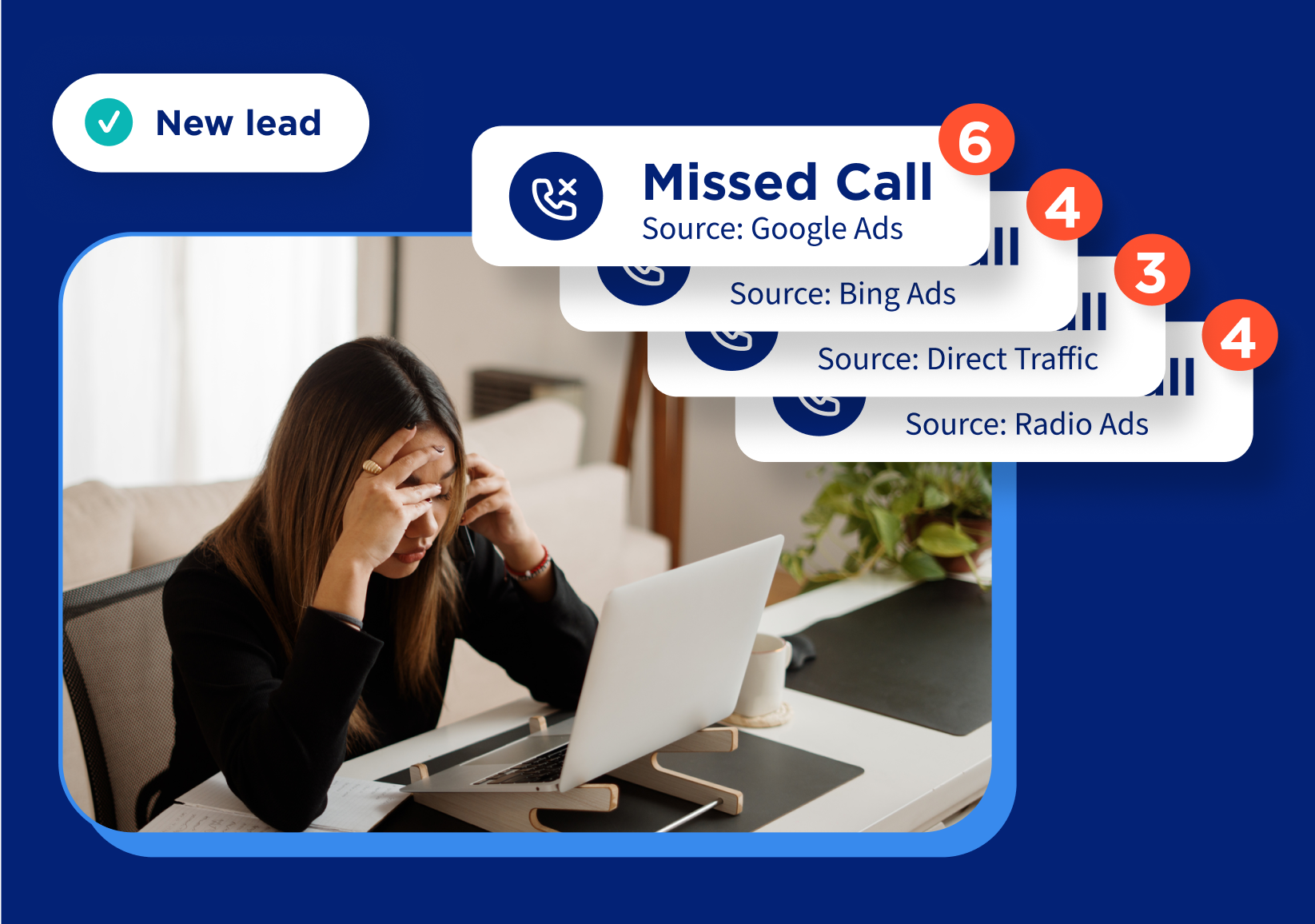A solid HVAC marketing strategy identifies the most effective channels that will reach your ideal customers. But with so many channels to choose from, it can be hard to know which ones will drive the most qualified leads.
This article highlights top HVAC marketing tactics and shows you how to implement them to grow your business.
1. Before you start, make sure you can track your marketing performance
Tracking your marketing efforts is one of the most crucial foundations for growing your HVAC business. If you don’t know what’s working and what isn’t, you can’t grow. When done properly, it helps you understand which campaigns are driving actual revenue and which are draining your budget without producing results.
A call tracking tool like CallRail assigns unique phone numbers to your ad campaigns, allowing you to identify which channels bring in the most leads. It also tracks form submissions on your website and integrates with other marketing tools to provide a complete picture of your marketing performance.
"We no longer have to run the company by feeling. We’ve got actual hard data now connecting the individual call and its outcome in revenue.”
—Mark King, Service Manager,
Home Heating & Air
The robustness of CallRail has given Home Heating & Air full visibility and control. They created a separate phone number for every campaign, including geofencing and print, enabling precision attribution. Plus, managers now get custom scorecards based on real call outcomes.
By tracking your marketing effectively, you can optimize spend, test new ideas faster, and grow with confidence.
2. Make your website a lead-generation tool
Your website is often the first impression potential customers will have of your HVAC business, so you must make sure that it communicates clearly:
- The services you offer
- What makes you different from the competition
- What action customers should take on your site (contact, request a quote, etc.)
You may want to try different calls to action to see what resonates with your audience and generates more leads. A call to action is any design element meant to prompt an immediate response or encourage an immediate sale. For example, try a button that reads “Schedule a Service” on one page. After you’ve collected data, change it to “Get a free estimate” and see which one gets more clicks.
It’s also a good idea to feature reviews and testimonials on your website. Videos and quotes showing satisfied customers can help build trust and credibility with incoming leads, making them more likely to choose your HVAC business over your competitors. Website plugins from Yelp and Google are also a great way to showcase reviews from popular sites for prospects to view while they browse your site.
3. Connect with your local community using traditional marketing
HVAC businesses are locally based, and your best customers live close to you. Though there are ways you can use digital marketing to reach them (see HVAC marketing method #4), sometimes nothing beats tried and true marketing techniques.
Ads in public places, such as benches and buses, can help increase brand awareness and reach a wider audience – along with placements in flyers and print ads. Local radio stations are also a great way to reach your target audience, especially if you know which stations they listen to and purchase spots at high traffic times (like during morning commutes).
Sponsoring local teams, art performances, and events like festivals can also help you improve brand recognition and connect with your community. Create ads that offer special deals and discounts to attendees, or send sales representatives to these events with stickers, magnets, and business cards.
To track the success of your traditional marketing efforts, set up unique phone numbers for each physical ad you run. This way, you can renew ad placements that are driving leads, and scrap those that don’t boost your business.
4. Use local search to rise above your competitors
Make sure your Google Business Profile (formerly Google My Business) is set up correctly and thoroughly filled out. Include your up-to-date business hours, contact information, and current photos of your business. This will improve your visibility in local search results and make it easier for potential customers to find and contact your HVAC company. For more guidance on setting up Google My Business, check out our Ultimate Guide to your Google Business Profile.
In addition to advertising to community members with real-life ads, you’ll also want to dedicate some of your HVAC marketing budget to reaching people who are searching for local services online. One of the most important things you can do to generate leads for your HVAC business is to optimize your website for local SEO. You can do this by adding pages for the areas you service on your website and including content relevant to the most popular services you offer on each of those pages.
5. Improve lead retention with automated responses
Automated text message responses are an excellent way to engage with potential homeowners while keeping up with your busy schedule. Response time is critical with these customers. With a tool like CallRail, you can provide leads with more information about your HVAC services without having to drop everything you’re doing and pick up the phone.
Another tactic for managing missed calls is Voice Assist, a dedicated AI-assistant that can answer, capture, and qualify inbound calls. Long after you’ve closed up shop for the day or on busy days when you need to prioritize current clients, Voice Assist can work around the clock, – engaging with prospects in order to keep your business growing.
Pairing a lead capture and engagement strategy with Convert Assist can help you take advantage of AI insights to draw on precise action plans and next steps for each new prospect. Ready-to-send messages are tailored to enable quick re-engagement, allowing you or your team to translate leads to customers far quicker. By managing your ongoing leads through CallRail’s dedicated texting and mobile app, your sales strategy can keep momentum regardless of whether leads come in after hours or while you are on a service call.
6. Find ways to generate more positive reviews
Positive reviews can be a powerful tool for attracting new customers to your HVAC business. In fact, according to recent research, 93% of consumers say online reviews impact their decision to buy from a business.
You can earn more positive reviews by following up with customers after a job is complete. Send an automated text that includes a friendly reminder to leave a review, and provide a direct link to the review page (like your Google My Business listing). Streamlining the process for them increases the likelihood that they will take the time to do so. Making it mobile-friendly allows them to leave the review from anywhere.
Also, be sure to follow up on reviews, especially if they are negative. Responding to reviews shows you value your customers' feedback and are committed to improving your services. If you receive negative reviews, address them professionally and work with the customer to resolve any issues. This can help turn a negative experience into a positive one and show potential customers that you care about their satisfaction.
7. Use Conversation Intelligence to understand what your customers want
Understanding what your customers are saying — and what they actually need — is key to delivering exceptional service and growing your HVAC business. CallRail's Conversation Intelligence® helps you do exactly that by automatically transcribing and analyzing your customer calls.
This not only saves time but also provides powerful insights to improve your sales approach, staff training, and marketing messages.
"Instead of listening to each recording individually, I can just scan the AI-generated transcripts — reducing my time spent by at least 70%."
—Mark King, Service Manager,
Home Heating & Air
For Home Heating & Air, these tools have delivered dramatic efficiency gains and business results:
- Call review time dropped from 5 days to 5 hours
- AI-generated transcripts now save the team 70% of the time it used to take to review calls
- Customized tagging and tracking enables call scoring, faster follow up, and the ability to identify which marketing campaigns are most effective
Mark explains that having this kind of insight transformed their operations. “We had opportunities upwards of $45,000 in value [each month] that we were leaving on the table. We were able to take that down to just thousands each month by using CallRail.”
8. Transform your HVAC marketing with CallRail’s AI-powered insights
Any combination of these HVAC marketing strategies can help generate more leads for your business. With the right tracking tools in place, you can analyze and test your efforts to cut your marketing spend while getting more new business than ever.
See how CallRail's lead engagement platform gives you a complete picture of your marketing's effectiveness.










